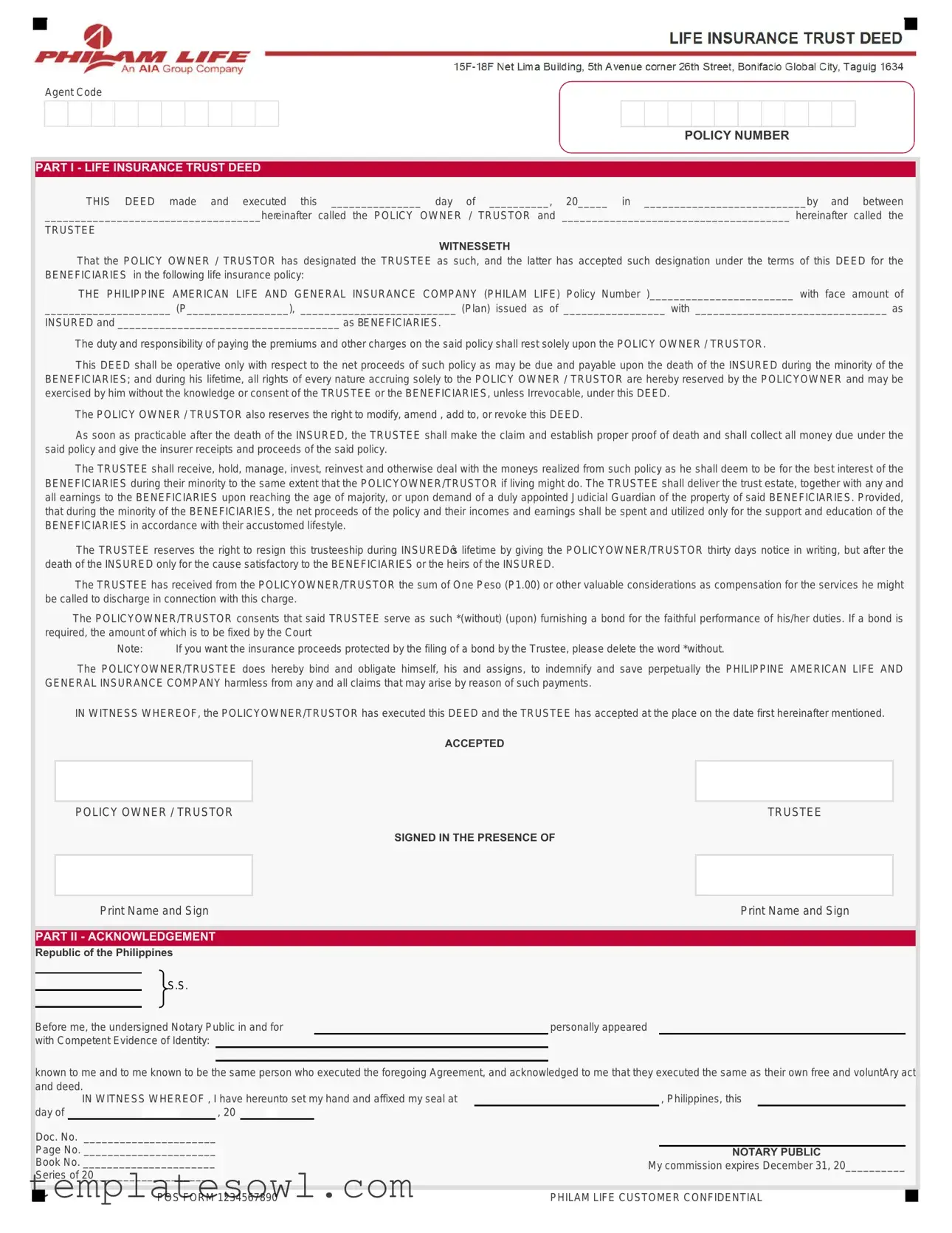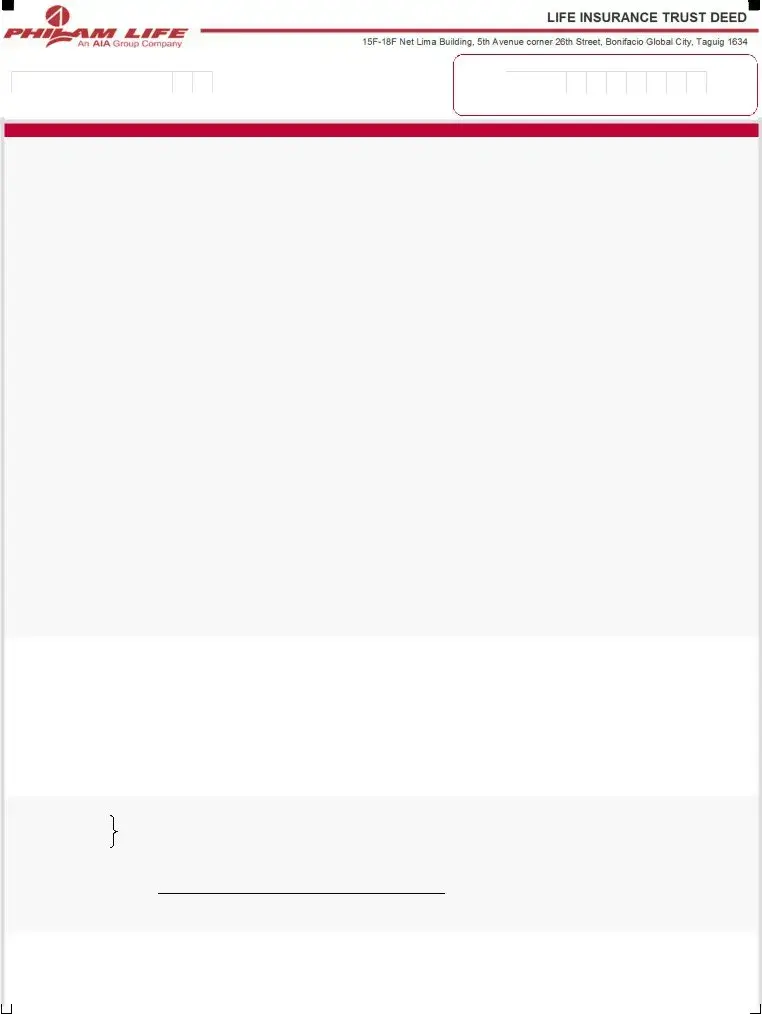LIFE INSURANCE TRUST DEED
15F-18F Net Lima Building, 5th Avenue corner 26th Street, Bonifacio Global City, Taguig 1634
Agent Code
POLICY NUMBER
PART I - LIFE INSURANCE TRUST DEED
THIS DEED made and executed this _______________ day of __________, 20_____ in ___________________________by and between
____________________________________hereinafter called the POLICY OWNER / TRUSTOR and ______________________________________ hereinafter called the
TRUSTEE
WITNESSETH
That the POLICY OWNER / TRUSTOR has designated the TRUSTEE as such, and the latter has accepted such designation under the terms of this DEED for the BENEFICIARIES in the following life insurance policy:
THE PHILIPPINE AMERICAN LIFE AND GENERAL INSURANCE COMPANY (PHILAM LIFE) Policy Number )________________________ with face amount of
_____________________ (P_________________), __________________________ (Plan) issued as of _________________ with ________________________________ as
INSURED and _____________________________________ as BENEFICIARIES.
The duty and responsibility of paying the premiums and other charges on the said policy shall rest solely upon the POLICY OWNER / TRUSTOR.
This DEED shall be operative only with respect to the net proceeds of such policy as may be due and payable upon the death of the INSURED during the minority of the BENEFICIARIES; and during his lifetime, all rights of every nature accruing solely to the POLICY OWNER / TRUSTOR are hereby reserved by the POLICYOWNER and may be exercised by him without the knowledge or consent of the TRUSTEE or the BENEFICIARIES, unless Irrevocable, under this DEED.
The POLICY OWNER / TRUSTOR also reserves the right to modify, amend , add to, or revoke this DEED.
As soon as practicable after the death of the INSURED, the TRUSTEE shall make the claim and establish proper proof of death and shall collect all money due under the said policy and give the insurer receipts and proceeds of the said policy.
The TRUSTEE shall receive, hold, manage, invest, reinvest and otherwise deal with the moneys realized from such policy as he shall deem to be for the best interest of the BENEFICIARIES during their minority to the same extent that the POLICYOWNER/TRUSTOR if living might do. The TRUSTEE shall deliver the trust estate, together with any and all earnings to the BENEFICIARIES upon reaching the age of majority, or upon demand of a duly appointed Judicial Guardian of the property of said BENEFICIARIES. Provided, that during the minority of the BENEFICIARIES, the net proceeds of the policy and their incomes and earnings shall be spent and utilized only for the support and education of the BENEFICIARIES in accordance with their accustomed lifestyle.
The TRUSTEE reserves the right to resign this trusteeship during INSURED’s lifetime by giving the POLICYOWNER/TRUSTOR thirty days notice in writing, but after the death of the INSURED only for the cause satisfactory to the BENEFICIARIES or the heirs of the INSURED.
The TRUSTEE has received from the POLICYOWNER/TRUSTOR the sum of One Peso (P1.00) or other valuable considerations as compensation for the services he might be called to discharge in connection with this charge.
The POLICYOWNER/TRUSTOR consents that said TRUSTEE serve as such *(without) (upon) furnishing a bond for the faithful performance of his/her duties. If a bond is required, the amount of which is to be fixed by the Court
Note: |
If you want the insurance proceeds protected by the filing of a bond by the Trustee, please delete the word *without. |
The POLICYOWNER/TRUSTEE does hereby bind and obligate himself, his and assigns, to indemnify and save perpetually the PHILIPPINE AMERICAN LIFE AND GENERAL INSURANCE COMPANY harmless from any and all claims that may arise by reason of such payments.
IN WITNESS WHEREOF, the POLICYOWNER/TRUSTOR has executed this DEED and the TRUSTEE has accepted at the place on the date first hereinafter mentioned.
|
|
|
|
|
|
ACCEPTED |
|
|
|
|
|
|
|
|
|
|
|
|
|
|
|
|
|
|
|
|
|
|
|
|
|
|
|
|
|
POLICY OWNER / TRUSTOR |
|
|
|
TRUSTEE |
|
|
|
|
|
|
|
SIGNED IN THE PRESENCE OF |
|
|
|
|
|
|
|
|
|
|
|
|
|
|
|
|
|
|
|
|
|
|
|
|
|
|
|
|
|
Print Name and Sign |
|
|
|
Print Name and Sign |
|
|
|
|
|
|
|
|
|
|
|
|
|
|
|
PART II - ACKNOWLEDGEMENT |
|
|
|
|
|
|
|
|
Republic of the Philippines |
|
|
|
|
|
|
|
|
|
|
S.S. |
|
|
|
|
|
|
|
|
|
|
|
|
|
|
|
|
|
|
|
|
|
|
|
|
|
|
|
Before me, the undersigned Notary Public in and for |
|
personally appeared |
|
|
with Competent Evidence of Identity: |
|
|
|
|
|
|
|
|
known to me and to me known to be the same person who executed the foregoing Agreement, and acknowledged to me that they executed the same as their own free and voluntAry act
|
and deed. |
|
|
|
|
|
|
|
|
|
|
|
|
|
|
|
IN WITNESS WHEREOF , I have hereunto set my hand and affixed my seal at |
|
|
, Philippines, this |
|
|
day of |
|
|
|
, 20 |
|
|
|
|
|
|
|
|
|
|
|
|
Doc. No. ______________________ |
|
|
|
|
|
|
|
|
|
|
|
|
|
Page No. ______________________ |
|
|
|
|
|
|
|
NOTARY PUBLIC |
|
|
|
|
Book No. ______________________ |
|
|
|
|
|
My commission expires December 31, 20__________ |
|
|
Series of 20____________________ |
|
|
|
|
|
|
|
|
|
|
|
|
|
|
|
|
|
|
|
|
|
|
|
POS FORM 1234567890 |
PHILAM LIFE CUSTOMER CONFIDENTIAL |
|
|
|
|
|
|
|
|

